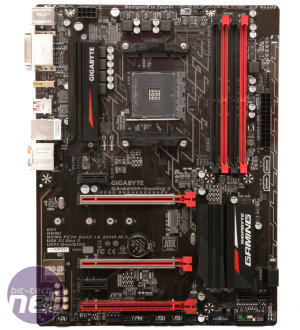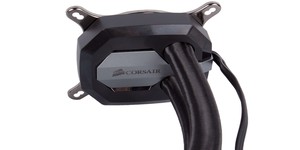
Enthusiast Gamer
The Enthusiast Gamer is all about using cost-effective hardware to net you a system that's suitable for premium 1080p gaming (or even 1440p with a GPU upgrade), has all or most of the latest features, and will last for a long time. It's also VR ready, meeting or exceeding the minimum specifications of the HTC Vive and Oculus Rift headsets. It's what we would consider the go-to component choices for most enthusiasts.| Product | UK price (inc VAT) | US price (ex tax) | |
| CPU | AMD Ryzen 5 1400 | £170 | $170 |
| Motherboard | Gigabyte AB350-Gaming 3 | £105 | $110 |
| Memory | 16GB (2 x 8GB) 3,000MHz DDR4 | £120 | $120 |
| Graphics card | Sapphire Radeon RX 580 Nitro Pulse 8GB | £220 | $230 |
| PSU | Corsair CS550M | £60 | $80 |
| CPU cooler | MSI Core Frozr L | £50 | $50 |
| Storage (primary) | Crucial MX300 525GB | £135 | $150 |
| Storage (secondary) | 2TB SATA 6Gbps HDD | £65 | $70 |
| Case | Phanteks Enthoo Pro M | £70 | $70 |
| Total price | £995 | $1,050 |
We again wanted to lower the price of this system. £1,100 was the cost of the previous configuration, whereas £1,000 was our new target, and this time we just about managed it.
 The major change here is a move from Intel to AMD's new Ryzen platform. Our CPU of choice is the Ryzen 5 1400, the lowliest of the bunch but still a CPU with four cores and eight threads. Now, these run slower than they do on the four-core/four-thead Intel Core i5-7600K, and even if you overclock the Ryzen CPU this will be true, but the multi-theading on AMD's chip has the potential to be very beneficial, and we've saved £50 in this choice of CPU as well. If you won't be overclocking, consider the £190 Ryzen 5 1500X, which has higher base, boost, and XFR frequencies, so will always be faster out of the box. Honestly, a Core i5-7600K would still be a great choice here, and overclocking will make up some of its deficit in multi-threaded workloads. However, cost is still a primary factor in this system, and Ryzen really excels in value for money versus Intel.
The major change here is a move from Intel to AMD's new Ryzen platform. Our CPU of choice is the Ryzen 5 1400, the lowliest of the bunch but still a CPU with four cores and eight threads. Now, these run slower than they do on the four-core/four-thead Intel Core i5-7600K, and even if you overclock the Ryzen CPU this will be true, but the multi-theading on AMD's chip has the potential to be very beneficial, and we've saved £50 in this choice of CPU as well. If you won't be overclocking, consider the £190 Ryzen 5 1500X, which has higher base, boost, and XFR frequencies, so will always be faster out of the box. Honestly, a Core i5-7600K would still be a great choice here, and overclocking will make up some of its deficit in multi-threaded workloads. However, cost is still a primary factor in this system, and Ryzen really excels in value for money versus Intel.For the motherboard, we've gone for the Gigabyte AB350-Gaming 3, which won our Recommended award and costs the same as entry-level Z270 boards. The B350 chipset only lacks in a few areas compared to the X370 one (multi-GPU being the main one), and our sample at least didn't fall short in overclocking, so your chip is likely to be the bottleneck here. This motherboard also has good onboard sound, M.2 support, and USB 3.1 Gen2 (although only Type-A ports).
Our 16GB of DDR4 is sadly £20 more expensive than before. There's little reason opting for anything beyond 3,000MHz on AMD, but do remember to set the memory frequency correctly in the BIOS.
 The RX 480 8GB has been swapped for an RX 580 8GB, which is the same GPU just running at slightly faster speeds. It offers excellent 1080p performance and can even handle itself at 1440p and in VR. The Sapphire Pulse card has the same design as the Nitro+ RX 480 we used to recommend, but its boost clock is higher since it's an RX 580 now, and it's actually less expensive too. That said, you may be able to get an even better deal on outgoing RX 480 parts. This system also provides a solid base for future upgrades, as the GPU will continue to be the limit in games before anything else. The GTX 1070 is a big stretch in price, but if your budget is £1,200 instead of £1,000 then it would be the first place where we'd invest more. On the flip side, you could pick a 4GB RX 580 SKU to save cash, but only if you'll be sticking to 1080p for the foreseeable future.
The RX 480 8GB has been swapped for an RX 580 8GB, which is the same GPU just running at slightly faster speeds. It offers excellent 1080p performance and can even handle itself at 1440p and in VR. The Sapphire Pulse card has the same design as the Nitro+ RX 480 we used to recommend, but its boost clock is higher since it's an RX 580 now, and it's actually less expensive too. That said, you may be able to get an even better deal on outgoing RX 480 parts. This system also provides a solid base for future upgrades, as the GPU will continue to be the limit in games before anything else. The GTX 1070 is a big stretch in price, but if your budget is £1,200 instead of £1,000 then it would be the first place where we'd invest more. On the flip side, you could pick a 4GB RX 580 SKU to save cash, but only if you'll be sticking to 1080p for the foreseeable future.The power supply has actually gone down in price; £60 is very good value for what you get here (80 Plus Gold and semi-modular). We've tested the CS550M ourselves so can vouch for its quality.
We've ditched our all-in-one liquid cooler for a decent air cooler, the MSI Core Frozr L, which has AM4 support out of the box and performs well without getting too loud. If you're set on liquid, however, we recommend the Arctic Freezer series for a solid combination of simple design, high performance, and decent noise levels.
We've also gone from the tempered glass version of our Phanteks case to the normal one, as the glass is more of a luxury. We think it's a compelling upgrade, but in the interest of our £1,000 budget, we decided we could do without it. The NZXT S340 is another case well worth looking at if you're not keen on our choice here, and it too has a glass version, the NZXT S340 Elite, if you've a little extra cash to play with.
The storage choice is the same (although pricing is higher for the SSD) and prioritises capacity over speed; NVMe SSDs are too expensive for what they offer for this system and have virtually no benefit in games. Our SSD/HDD combination lets you install half a dozen or more modern games comfortably on your boot drive, with many more backed up to the 2TB mass storage hard disk.

MSI MPG Velox 100R Chassis Review
October 14 2021 | 15:04








Want to comment? Please log in.